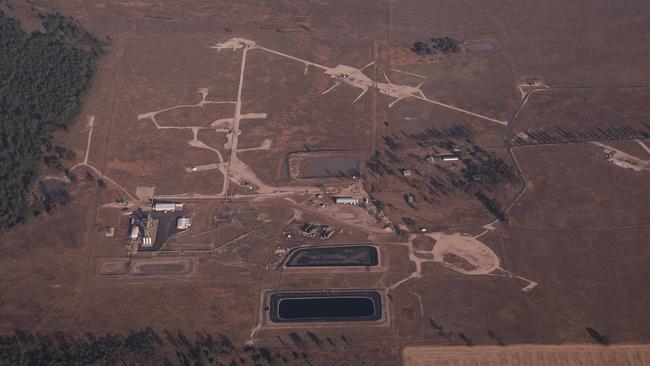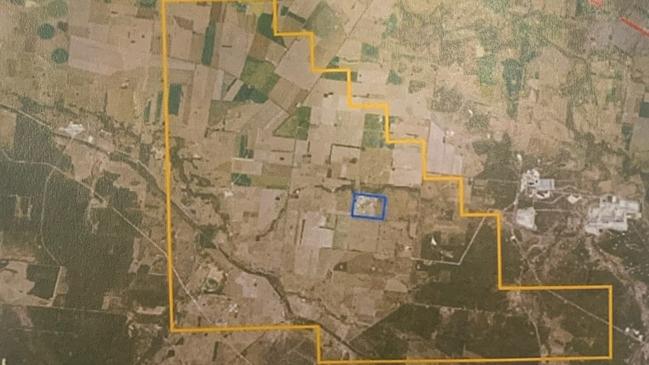Queensland kept toxic chemical water contamination scandal secret
Dangerous levels of toxic chemicals have been found in groundwater outside one of Australia’s worst contamination disaster sites, but it’s been kept secret from landholders.

Dangerous levels of toxic chemicals have been found in groundwater outside one of Australia’s worst environmental contamination disaster sites, but the information has been kept secret from landholders amid warnings of possible legal action against the Queensland government.
Cyanide and the highly carcinogenic chemical benzene were first detected in April last year in state-owned groundwater monitoring bores up to 700m outside the boundary of the former Linc Energy underground coal gasification (UCG) project at Hopeland, nestled in prime farmland on the Darling Downs.
Leaked documents from Queensland’s Department of Environment and Science show the extent of the impact to groundwater was “currently unknown’’.
The discovery has been kept from nearby landholders and the local council, and has yet to be included on a state land-contamination register, possibly constituting multiple breaches by the Palaszczuk government under “duty to notify” obligations in the state Environmental Protection Act. It has raised serious questions about the government’s recent decision to transfer responsibility for monitoring the Linc site from the Department of Environment and Science to the Department of Resources.
Linc Energy, which was initially in a joint venture with the state-owned CS Energy, conducted an experimental project that generated gas by setting fire to underground coal seams, from 2000 to 2013.
An Environment Department investigation shut down the operation. In 2018, the then-liquidated company was fined $4.5m after being convicted on five charges of wilfully and unlawfully causing environmental harm, after its pilot plant released toxic gases and chemicals into soil, air and water.

The government has spent tens of millions of dollars cleaning up and monitoring the site. Ever since, monitoring bores on the Linc site have consistently shown the groundwater is contaminated.
But in late 2020, the Environment Department installed four groundwater bores 400m to the north and 700m to west of the boundary of the Linc site to test if the contamination had spread. The first sample results were delivered in April, last year.
Repeated testing of the bores over the past 18 months have shown levels of benzene, a chemical linked to causing leukaemia and other blood cancers, that are up to 25 times the maximum limit in Australia’s drinking water quality and livestock watering guidelines. Cyanide levels in the bores, which border grazing paddocks and farmland, have been found to be up to 10 times the same standards.
Testing of water bores on nearby farms and properties has not found any trace of UCG by-products.
“The immediate risk to the health and safety of landholders is low,’’ Environment Department scientists wrote in one document.
Officials told environment department bosses and a string of Palaszczuk government ministerial advisers in an emailed “alert” in May last year that: “This is the first time potential UCG by-products have been observed in the groundwater offsite.’’
Around the same time government scientists found the high levels of benzene and cyanide in the offsite bores, a coal seam gas company made an application for state approval to begin drilling hundreds of new wells on land surrounding the Linc site.
Arrow Energy, a joint venture between Shell and PetroChina, has proposed 280 wells as part of its $10bn Surat Gas Project.
Last year, after unspecified discussions with the Environment Department, Arrow announced it would wind back its application to just 55 wells on the land neighbouring Linc, with an application for approval for the remaining 225 wells to be made at a later date. Arrow’s proposal is still being assessed.
The leaked documents and emails from the Department of Environment and Science show officials repeatedly warned of the potential risks of the test results getting into the public domain if they informed local landholders, council and Arrow Energy.
One email played down the risk of Arrow Energy publicly divulging the bore’s sample results because “it may raise concerns that the monitoring results could impact an existing environmental authority amendment application related to the Hopeland region’’.
Another document highlights the potential risks that public disclosure could help a threatened class action against the state over its regulation of Linc Energy.
“Information will be publicly available identifying that UCG by-products have been observed in the groundwater off-site,” a draft Hopeland Groundwater Off-site Contaminant Notification Communication Plan states in May this year.
“Media may find this publicly available information, and this would be beneficial to any civil proceedings against the state.’’
The May 12, 2021, email from the Environmental Services and Regulation unit alerted the department’s top bureaucrats, including Director-General Jamie Merrick, and a string of ministerial advisers to the purpose of the tests and their initial findings.

“The bores were installed to enhance the existing groundwater monitoring program to aid in detecting and proactively monitoring for underground coal gasification (UCG) by-products, and to gather evidence for the prosecution of Linc executive officers,’’ the email said. “The results indicate potential UCG by-products in three of the four groundwater monitoring bores exceed relevant Australian drinking water quality and Livestock watering guidelines for Benzene.’’
The emailed alert reported that other groundwater monitoring bores on the Linc site and along its perimeter had also found UCG by-products.
“Arrow concludes that monitoring of their bores located offsite and adjacent to the former Linc site do not show a clear indication of UCG related by-products,’’ the email said.
Despite the results, Queensland prosecutors dropped environmental charges against Linc’s chief executive Peter Bond and three other Linc executives just months later.
The government also went ahead with its plan to transfer control and monitoring of the land from the Environment Department to the Resources Department.
Other internal government documents, obtained by The Weekend Australian, show that officials had devised a plan to inform neighbouring landholders and the local council of the groundwater test results under “duty to notify of environmental harm” provisions.
Landholders and the council, the owner of land on which two of the new testing bores have been drilled, told The Weekend Australian they had never been notified.
A series of questions was this week sent to the office of Environment Minister Meaghan Scanlon about the groundwater test results. The questions were referred to her department.
In a brief statement, the department did not answer questions about the government’s understanding of the test results, their impact on the neighbouring Arrow Energy proposal or the failure to notify landholders.
“Benzene and cyanide were found during monitoring of bores on Kummerows Road, but not in bores owned by landholders nearby,’’ it said.








To join the conversation, please log in. Don't have an account? Register
Join the conversation, you are commenting as Logout